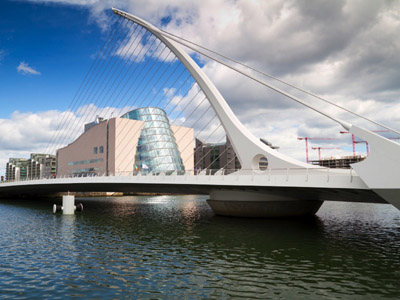Ernest Thomas Sinton Walton (1903-1995). Image from Wikimedia Commons
What better way to celebrate Dublin’s 2012 tenure as European City of Science than to name the new Marlborough Street bridge in the capital city after Ernest Walton, the Irish physicist who won the Nobel Prize in Physics in 1951 along with John Cockcroft.
The duo became the first scientists to artificially split the atom back in 1932 as a result of their atom-smashing experiments.
The Institute of Physics (IOP) in Ireland is now campaigning to have the planned bridge that will span the River Liffey in Dublin City at Marlborough Street named the Ernest Walton Bridge.
The institute has created an online petition to canvas support to get Dublin City Council to name the bridge after the Irish physicist. To date, Walton remains Ireland’s only Nobel Prize winner in the sciences.
It was in 1932 that Walton and his colleague Cockcroft became the first to artificially split the atom in the Cavendish Laboratory in Cambridge, a scientific leap that was to earn them the Nobel Prize in Physics in 1951.
As for the bridge, construction work on it started in November. When it’s completed, it will be a transport, cycle and pedestrian bridge linking Marlborough Street and Eden Quay on the north side of the Liffey to Hawkins Street and Burgh Quay on the south side.

Samuel Beckett Bridge, named after the Irish writer, is a cable-stayed bridge that spans the River Liffey in Dublin City. Opened in 2009, the bridge cost €60m to build and its design aims to evoke the image of a harp lying on its side
Visionary for Ireland
So here’s a little bit more about Ernest Thomas Sinton Walton and why the IOP thinks he is deserving of Dublin city’s newest bridge being named after him.
Walton was born in 1903 in Abbeyside in Co Waterford. His father was Reverend John Walton, a Methodist minister from Co Tipperary. His mother was Anna Sinton.
The family moved every three years, due to Walton’s father being a clergyman, so that meant the young Walton attended schools in places such as Rathkeele, Co Limerick, Banbridge, Co Down and Cookstown, Co Tyrone. Walton also attended Wesley College in Dublin, before becoming a border at Methodist College, Belfast, in 1915. It was there that he apparently excelled in maths and science.
Then, in 1922, he won a scholarship to study at Trinity College Dublin (TCD). While there, he studied maths and experimental science, specialising in physics. He graduated in 1926 and subsequently received his MSc degree in 1927.
According to Nobelprize.org, in 1927, Walton was awarded a research scholarship at Cambridge University to work in the Cavendish Laboratory under Lord Rutherford.
He received his PhD in 1931 at Cambridge.
Birth of modern physics
Then, in 1932, Walton and his co-worker Cockcroft became the first individuals to artificially split the atom in the Cavendish Laboratory, which was apparently the world’s leading research centre in atomic and nuclear physics research at the time.
The two scientists had built an apparatus that split the nuclei of lithium atoms bombarding them with a stream of protons accelerated inside a high-voltage tube. Thus they paved the way for modern physics advancements, such as what is being carried out in the Large Hadron Collider at CERN today.
According to IOP in Ireland, Walton’s and Cockcroft’s experiment had several important outcomes, including the verification of Einstein’s equation relating mass and energy, E=mc2.
“Walton was at the birth of modern physics, as carried out in CERN and elsewhere throughout the world,” said the institute.
Walton returned to Dublin in 1934 where he continued to work as a lecturer and researcher in the Physics Department at TCD.
Campaigning the Irish Government in 1957 about science
However, his contribution to Ireland went far beyond his role as an educator, according to Prof Peter Gallagher and Prof Vincent McBrierty from TCD, in their contribution on the IOP web post.
“In 1957, he wrote to the Government about the importance of science in the development of the nation,” they wrote.
“He advocated the need for a stronger science base in the country that would drive Irish industrial growth some two years before the Whitaker-Lemass programme for Ireland’s sustained economic progress.”
Knowledge economy forefather
And the IOP is also claiming Walton was the forefather of the knowledge economy.
“He, in fact, had predicted the advent of the knowledge economy at a very early stage and proposed a plan for economic development that remains a viable template for progress today.”
The IOP goes on to say: “Naming the Marlborough Street bridge ‘The Ernest Walton Bridge’ will celebrate this unique Irishman, and inspire school children to pursue further study and careers in science and technology, a key objective of the Government.”
Walton married Frieda Wilson in 1934 and they had five children. He died in 1995 at the age of 91.